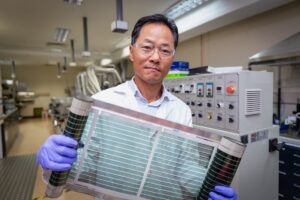Researchers at Lund University in Sweden have developed a novel type of solar cell, made up of tiny solar-radiation collecting nanowire antennae, that can harness more of the solar spectrum than conventional solar cells, and could be used to power satellites in space.
The new technology joins a growing host of projects designed to harness solar energy in space – some of which, in a move that sounds more sci-fi than science, even hope to beam the harvested power back down to Earth in the form of microwaves.
The new cells from Lund University are made of one nanowire that’s a composite of three different materials that react to different wavelengths of light from the sun.
Prototypes of the new cells, developed by solid-state physicists Magnus Borgström and Lukas Hrachowina, were rocketed into Earth’s orbit a few days ago, with the satellite they’ll power due to come online in the Northern Spring.
The new technology is a form of tandem cell – cells with different band gaps that can harvest more energy from the sun’s wide-spectrum light – but unlike current tandem cells, which generally involve combining different semiconducting materials on top of a silicon base, the new prototype is made up of extremely thin rods of semiconducting material on a substrate, which gives it a smaller amount of material per unit area, reducing costs and improving sustainability.
Borgström says he hopes the cells could massively boost solar efficiency compared with today’s commercial silicon solar cells which usually hover around 20%.
“Silicon solar cells have reached their maximum limit for efficiency,” he says. “Therefore, the focus has now shifted to developing tandem solar cells instead. The variants fitted on satellites are too expensive to put on a roof.”
The nanometre-thick rods consist of three materials that contain different amounts of indium, arsenic, gallium and phosphorus. In the lab, the researchers have thus far achieved a modest efficiency of 16.7%, but Lund colleague Yang Chen has reportedly demonstrated that the cells have the potential to reach 47% efficiency.

To take the cells further, the team will optimise the triple diodes by improving the tunnel junctions that connect the various materials in the structure.
According to the research team, the nanowire cells have two major benefits on conventional tandem cells – they are durable enough to withstand being battered by radiation in space, and they may prove able to absorb more light.
“A sheet of nanowires can be likened to a very sparse bed of nails,” Borgström explains. “If some aggressive protons came along, which happens now and then, they would probably land between the wires and if they happened to eliminate some wires, it would not matter very much. The damage could be worse if they land on a regular thin film.”
The cells have been fitted onto a research satellite launched into orbit in January by research partners at Caltech in the US.
The nanowire cells built by Lund and Caltech will most likely be used exclusively to power satellites, but among the solar-cell and space communities there are whisperings of loftier ambitions.
Speaking with Nature on Wednesday, James Carpenter, co-leader of the Solaris initiative, a feasibility study from the European Space Agency (ESA) that is looking to develop space-based solar arrays that could beam their power back to Earth, said such an ambitious project was feasible in the long-term.
“There’s nothing outlandish in this that would require new physics,” he said.
Such an array would need to be kilometres wide, made from lightweight and efficient materials, and able to withstand intense radiation. The energy harvested from these rays would then need to be converted into microwaves that could be beamed down through the atmosphere without losing much energy, and received by kilometre-wide receiving systems.
But experts say extensive research would be needed to make such a system viable: converting the power produced into microwaves and then back into electricity on the ground would, with today’s technology, be deeply inefficient.










